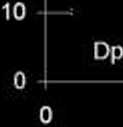9345765630
Doc. No.
Snohvit C02 Tubaen Fm. storage capacity and inj«ction strategy study
Valid from
Rev. no. 1.0
Snohvit4D seismic and pressure match
80
70
60
|
— |
— |
1IL |
b | |
|
— |
— |
— |
— |
— |
|
— |
T 50
JO

M
H
Ol

20

I-
70.6 qBm/kh * ln(1.781 *948‘Fmc,r> / kt)
1 10 100 1000 10000 Equivalent radius [m]
Figurę 53: The calibrated ‘seismic pressure* plotted versus area of the two seismic anomalies (equivalent radius). The pressure - area is compared with a idealistic homogeneous 10 m thick infinitive reservoir model, from text book"Well testing”John Lee 1982.
In Figurę 53, the area of difference amplitudes above a given threshold value are shown as function of a disc with radius equivalent to the area. Amplitudę values have been linearly scaled to pressure using an arbitrary scalę factor, but roughly in agreement with the ~60 bar increase observed in the well shut-in pressure during seismic acquisition. The red curve is of the lowermost horizon, associated with Tubaen 1, while the light blue curve is the event associated with Tubaen 2 and Tubaen 3. For comparison, a theoretical curve with linear flow, is shown in violet. An interpretation of the Figurę is that for distances closer to the well than 100 m, saturation and temperaturę effects are causing increased amplitudę changes. The linear area (on a log-scale) between 100 m and 1000 m distance may be used to estimate effective permeability, and in this case a value around 250 mD is obtained for Tubaen 1 and around 50 mD for Tubaen 2 & 3. Another pressure scaling would ałter these numbers, but anyway, they are much lower than the several Darcy permeabilities reported from well 7121 /4-F-2 H (Table 2-4). These estimates are simplistic, and should be complemented by morę advanced analysis.
3.3.5 Discrimination of pressure and saturation effects
The observed 4D response is the combined effect of pressure increase and CO? saturation. Since both of these reduce the P-wave velocity, it is in generał not possible from the fuli difference stack alone to separate pressure and saturation. However, according to our rock physics models ( ), P-wave velocity is
reduced much morę by CO? saturation than by pressure. So by looking at the fuli stack amplitudę differences, we Classification: Intemal Status: Draft Expiry datę: 2012-12-31 Page61ofl32
Wyszukiwarka
Podobne podstrony:
Doc. No. Snohvit C02 Tubaen Fm. storage capacity and inj«ction strategy study Valid from Rev. no. 1.
SŁafoil Snohvit C02 Tubaen Fm. storage capacity and injection strategy study Doc. No. Valid
Statoil Doc. No. Snohvit C02 Tubaen Fm. storage capacity and inj«ction strategy study Valid from Rev
SŁafoil Snohvit C02 Tubaen Fm. storage capacity and injection strategy study Doc. No. Valid
1Statoil Snohvit C02 Tubaen Fm. storage capacity and inj«ction strategy study Valid from Rev. no. 1.
1Statoil Snohvit C02 Tubaen Fm. storage capacity and inj«ction strategy study Valid from Rev. no. 1.
MStatoil Snohvit C02 Tubaen Fm. storage capacity and inj«ction strategy study Valid from Rev. no. 1.
Statoil Snohvit C02 Tubaen Fm. storage capacity and inj«ction strategy study Valid from Rev. no. 1.0
1Statoil Snohvit C02 Tubaen Fm. storage capacity and inj«ction strategy study Valid from Rev. no.
Statoil Snohvit C02 Tubaen Fm. storage capacity and inj«ction strategy study Valid from I Rev. no.
1Statoil Snohvit C02 Tubaen Fm. storage capacity and inj«ction strategy study Valid from Rev. no.
1Statoil Snohvit C02 Tubaen Fm. storage capacity and inj«ction strategy study Valid from Rev. no. 1.
Statoil Snohvit C02 Tubaen Fm. storage capacity and inj«ction strategy study Valid from Rev. no. 1.0
1Statoil Snohvit C02 Tubaen Fm. storage capacity and inj«ction strategy study Valid from Rev. no. 1.
1Statoil Snohvit C02 Tubaen Fm. storage capacity and inj«ction strategy study 7 955 *10 Stotoon
Statoil Snehvit C02 Tubaen Fm. storage capacity and injection strategy study Doc. No. Valid
Statoil Snehvit C02 Tubaen Fm. storage capacity and injection strategy study Doc. No. Valid
Statoil Snehvit C02 Tubaen Fm. storage capacity and injection strategy study Doc. No. Valid
Statoil Snehvit C02 Tubaen Fm. storage capacity and injection strategy study Doc. No. Valid
więcej podobnych podstron